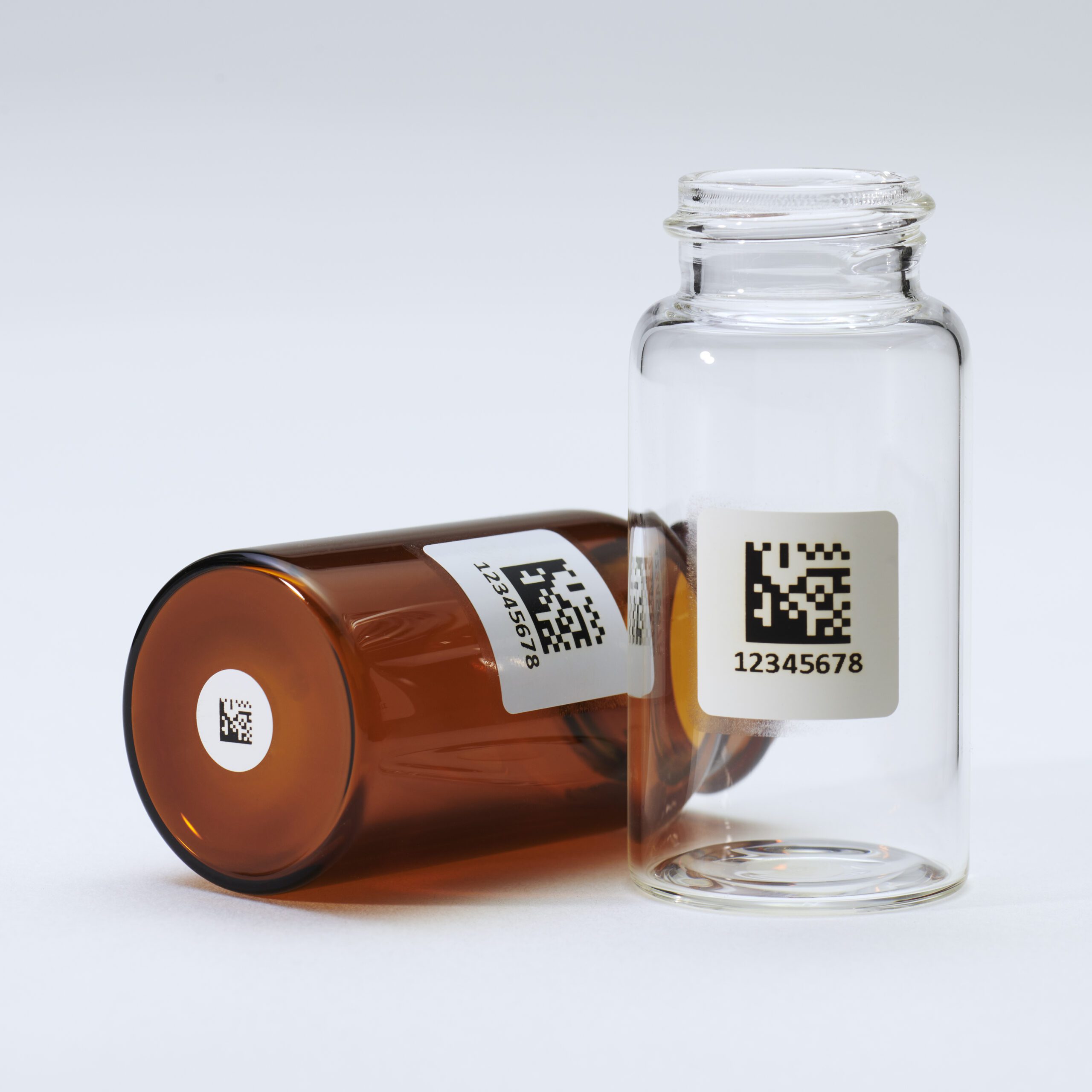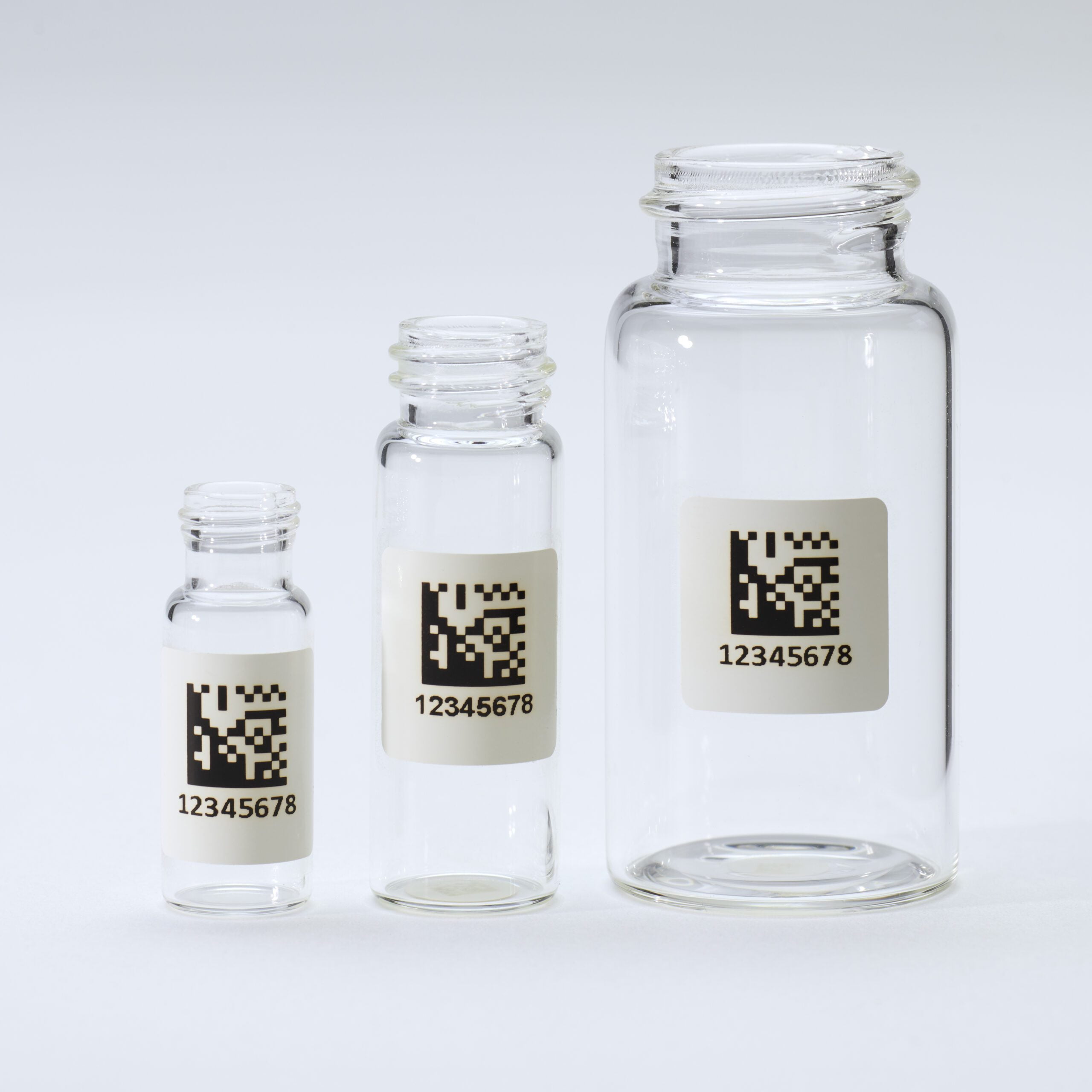Fused barcode marking technology is a virtually permanent marking solution for glass specimen containers. Its durability rivals the ceramic IDs also offered through our pre-barcoded labware service, but some labs may find it more accessible.
By permanently bonding to your glassware, fused barcodes can protect the identity and integrity of your high-value samples for the entire lifespan of the container.
Let’s break down everything you need to know about fused barcoding.
Advantages of Fused Barcoding
Your barcodes are printed onto our proprietary label construction which utilizes a post-application process to “fuse” the label in place and set the image. The result is a label with chemical and abrasion resistance, adhesion and weight stability that rivals our premium ceramic IDs.
The bonding process involves extremely high temperatures, making this method of identification unsuitable for plastic labware.
When high-value compounds or specimens are being identified, Fused IDs can help ensure proper identification and eliminate the opportunity for lost or unscannable labels.
Permanent and highly durable
Being bonded directly to the surface of your tubes or vials, fused labels are extremely durable, especially against chemical exposure and high temperatures.
Fused barcodes have proven to withstand temperatures as high as 230 degrees Celsius, as well as cryogenic storage and heptane or IPA soaks.
Can support stable tare weighing
Though the weight of adhesives can seem minuscule, if you’re looking for high-accuracy tare weights that remain stable over time, adhesive labels might not cut it.
Adhesives are impacted by their environment, including temperature and humidity—leading to changes in weight over time as they dry out or absorb water from the air. By bonding directly to glass surfaces, Fused labels eliminate that risk.
Cost effective
It would be fair to say fused marking is cost effective, particularly its similarities to our ceramic marking technology, and likely use cases are considered.
Fused identification offers a cost-effective way to ensure the identity of your high value specimens through long-term storage, extreme temperatures and chemical exposures.

How to know if Fused Barcoding suits your laboratory?
The technology behind Fused Barcoding is extremely durable under specific conditions. There are some criteria that first needs to be met before determining this will be suitable for your laboratory.
Using glass labware
Plastic labware performs better in certain situations. However, the high temperatures involved in the bonding process made fused IDs unsuitable for plastic surfaces.
Instead, if you require plastic labware, you may want to investigate our Cured Ink technology or seek a self-laminating pressure-sensitive option engineered to withstand your processes.
Need only black ink
Currently, colored inks aren’t compatible with our fused labeling process. If you require color or logo marks on your barcode labels, you may want to reconsider pressure sensitive options or investigate our Cured Ink technology.
Not printing on demand
Fused labeling is not suitable for in-house application. The marking, firing, and cooling processes take time, space, labor, and capital. These factors make it impractical to prepare a label for a sample on short notice or in-house.
If you need a print-on-demand solution, we recommend a pressure-sensitive label. If you’re struggling with your current pressure sensitive solution, seek suppliers who provide labels capable of accommodating processes similar to yours or custom engineering.
Temperatures under 230°C
As previously mentioned, Fused IDs are comparable to our ceramic labels in the sense that they outperform our pressure sensitive and Cured Ink options in terms of durability. However, there are a few circumstances where you might want to consider Ceramic over Fused IDs.
If your labware is expected to withstand temperatures over 230 degrees Celsius, Ceramic identification will be a better option for your specimens. Ceramic IDs are proven to remain intact at temperatures up to 500 degrees Celsius.
Additionally, Ceramic IDs are going to perform better when exposed to long term soaks in acetone, MEK, xylene and DMSO than Fused IDs.
If temperatures above 500 degrees Celsius, or long-term soaks in any of the above chemicals are regular practices in your facility, Ceramic IDs may be worth the premium cost. If not, then Fused IDs may offer you the opportunity to save.
Sourcing Fused IDs through our pre-barcoded services.
Fused labeling is a very straightforward offering within the scope of our pre-barcoded labware program.
Our team will discuss your specific labware, labeling and sequencing needs to ensure your labware performs to your standards. Little customization to the label is required outside of the sequence, sizing and placement—you will choose whether you would prefer a custom or generic sequence, linear or 2D barcodes, or both. Labels can be placed on the sides or bottoms of your vials. Human readable data can also be incorporated into the marking.
Additionally, with our pre-barcoded labware services, you can take advantage of a range of optional services, including tare weighing and custom packaging.
At its core, a Fused labeling strategy is a highly durable marking technology suitable for glass labware. Its performance is comparable to our Ceramic offering, but without the premium price tag. If you’re in need of durable, weight stable labeling for glass, Fused IDs can provide a cost-effective solution.


